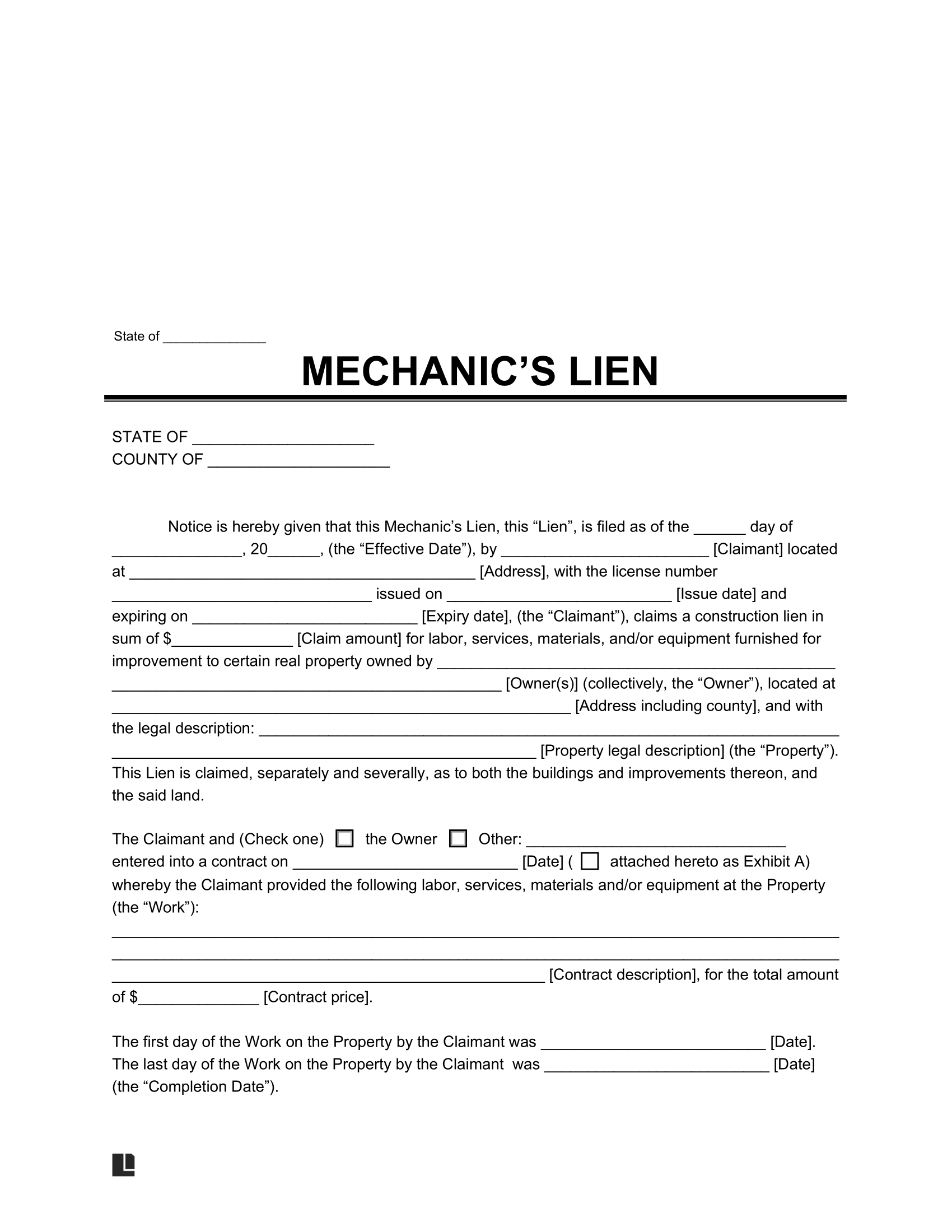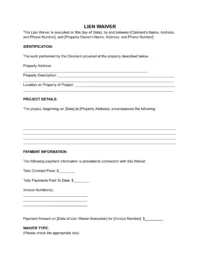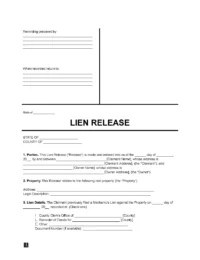A Mechanic’s Lien is a legal tool that can be used by skilled laborers seeking to recover money owed to them for services or materials provided on a project. If you are a contractor, subcontractor, or supplier who has not received payment for your work or supplies, filing a mechanic’s lien can increase your chances of securing the payment.
A lien waiver is provided and signed once the payment is received. This prevents any future liens on the property for the specific work or materials, protecting both the one who pays and the one who gets paid.
- What Is a Mechanic's Lien?
- Types of Mechanic's Lien Documents
- When Do I Need a Mechanic's Lien Form?
- Who Can File a Mechanic's Lien?
- Consequences of Not Having a Mechanic's Lien
- Common Situations for Using a Mechanic's Lien Form
- What Should Be Included in a Mechanic's Lien?
- Mechanic's Lien Sample
- Frequently Asked Questions
What Is a Mechanic’s Lien?
A mechanic’s lien is a formal notice filed with a court of appropriate jurisdiction indicating a financial interest in a property. Sometimes referred to as a contractor’s lien or a construction lien, this form details money owed to the contractor for either service rendered or materials provided on a construction or home or building improvement project.
Practically speaking, a builder or artisan cannot go back to the property and remove the structure they built or the paint they applied to the walls if they don’t get paid. However, a mechanic’s lien on the property preserves their claim for payment.
If the owner doesn’t pay the bill before selling the property, the lien will be addressed when it is sold. Additionally, a lien owner may force the sale of the home to satisfy the lien.
Types of Mechanic’s Lien Documents
You may need one or more of the following documents depending on your situation. Whether you’re asserting your right to payment or confirming that payment has been received, these forms ensure the lien process is handled legally and clearly.
Lien Waiver
Secure payment with a conditional or unconditional waiver.
Release of Mechanic's Lien
Formally release your claim once payment is complete.
When Do I Need a Mechanic’s Lien Form?
First, you must have provided goods or services to construct or improve real estate property. Different states have different rules about what constitutes appropriate work for a mechanic’s lien; however, generally speaking, the following work and contractors, if gone unpaid, may qualify for one:
- The provision of goods, such as lumber, plumbing supply, or electrical equipment;
- Labor, such as carpenters, plumbers, electricians, laborers, mechanical/HVAC contractors, etc.;
- Designers such as civil engineers and architects who were involved in the plans and specifications of the work and
- Fabricators of specialty items later installed or incorporated into the project.
Second, the work must be unpaid. If you have provided goods or services to enhance the real property, and your bill has not been paid, this form is an appropriate remedy.
In most states, even if a contractor has no direct contract with the property owner, they may file a lien. In other words, imagine a project run by a general contractor where the plumber is not paid for their materials or labor. Even though the plumber’s contract is with the general contractor and not the homeowner, the plumber may file a contractor’s lien against the homeowner directly.
Who Can File a Mechanic’s Lien?
A mechanic’s lien can be filed by contractors, subcontractors, laborers, and material suppliers on a property if they don’t get paid. If you’re a skilled laborer trying to collect money owed to you, you may likely be able to file a mechanic’s lien.
Consequences of Not Having a Mechanic’s Lien
Without one, a contractor risks not being paid for work performed or services provided. When a property owner doesn’t pay a bill for work done on the property, the mechanic’s lien gives the contractor a security interest and preserves the claim for payment.
When the property is sold, the proceeds will be divided among the various security interest holders, including first and second mortgages, tax liens, Homeowners Association (HOA) dues, and other construction liens, in the order of priority.
Any money over and above those debts will go to the property owner. However, without this form, the contractor will have no claim to the sale proceeds, and there is no guarantee that the funds due and owing will ever be paid.
Contractors should be cautious not to assume false security about a mechanic’s lien. For a lien to be legal, it must be perfected. Each state has its requirements for how to perfect a construction lien.
However, generally, the following steps must be taken for a contractor’s lien to be valid:
- First, in some states, the contractor must provide notice to the property owner that money is owed;
- Some states also require notices about the beginning of the work on the property and/or a public notice of intent to lien if it remains unpaid;
- Next, all states require a notice or claim of the lien to be filed in the requisite public records office. This notice must be filed within a specific period after either the work was completed or the materials were supplied;
- As state law dictates, the contractor must file a suit to foreclose the lien within a specific period.
A homeowner can remove the lien through two steps: First, the homeowner must pay the amount owed. Second, the lienholder must file the appropriate paperwork to release the lien.
Common Situations for Using a Mechanic’s Lien Form
This form is designed to protect contractors who, by their products or services, enhance the property’s value. Consequently, they are most commonly used in new construction or improvements to the property.
Not every cost associated with a project is subject to this form. For example, a contractor may bring in laborers to replace the roof of a home. The contractor is entitled to a mechanic’s lien for the shingles and other building materials and the labor costs for the workers who tear off the old roof and install the new roof.
However, the cost of the rental of a portable latrine or the installation and removal of a security fence, while perhaps necessary for the comfort and safety of the workers, may not be subjected to a mechanic’s lien. The latter does not increase the property’s value, while the new roof does.
There is a priority to liens against the property. Generally speaking, liens take precedence based on the order in which they are filed. Consequently, a first mortgage takes priority over this form, as the mortgage was filed first. However, this form may take priority over a second mortgage, depending on when the mechanic’s lien and the second mortgage were filed.
Of course, there are exceptions to the “first in time” rule. For example, a tax lien takes precedence over a mechanic’s lien. Additionally, Homeowner’s Association assessment liens may take precedence. Similarly, this lien may take precedence over other previously recorded liens, depending on the state.
What Should Be Included in a Mechanic’s Lien?
Each state has its mechanic’s lien laws, so there will be variations in what should be included in a lien. However, the table below addresses each topic contemplated by all the states for ease of use.
| What to include | Further information |
|---|---|
| Notice to the property owner | Some states require notice directly to the property owner. The notice should detail the work performed, the goods supplied, or both as applicable, with as much detail as possible. Include the dates the work started and was completed. |
| Notices about the beginning of the work | Depending on the state, this may be referred to as a Notice of Commencement, a Notice of Project Commencement, or an Affidavit of Commencement. This document details the start date of the project and is sent right before or immediately after the work begins. The notice should include the actual start date. Florida, Georgia, Iowa, and Ohio, for example, require this, where other states, such as South Carolina, South Dakota and Texas allow this as optional protection. |
| Public notice of intention to file | Before filing a lien, many states require the contractor file a Notice of Intent to Lien. This notice to the owner, given before the actual filing a lien, details the amount due, as well as the identity of the person or business planning to file the lien. The form of acceptable delivery of the notice is dictated by the state. |
| Notice of claim of lien filed | Notice must be provided to the homeowner that a lien has been filed. In some states, contractors above the filer within the chain of contractors working on the project must also be notified. Additionally, some states’ laws, such as the Illinois Mechanics Lien Act, require notice to other lien holders, such as the mortgagee. Depending on the jurisdiction, notice may be by mail, certified mail, registered mail, or served by the sheriff or a process server. |
| Filing Suit | The claimant must file an action with the relevant court within a specified time frame. In some states, this is referred to as a Lien Affidavit. In some states, such as Utah, the action must be served on the owner, along with instructions regarding the owner’s rights under the Residence Lien Restriction and Lien Recovery Fund Act, and an affidavit detailing how the homeowner may exercise their rights under the Act. |
Mechanic’s Lien Sample
Here’s what a typical Mechanic’s Lien looks like:

Download the template above or use our document builder to save time.
Frequently Asked Questions
How to put a mechanic’s lien on a house?
To put a mechanic’s lien onto a house or property, you need to follow three steps:
- Fill out a lien that adheres to the relevant state requirements
- Record the lien with the county
- Serve notice to the property owner
What happens when a mechanic’s lien is filed?
Once a mechanic’s lien is filed, there is typically a timeframe within which the lien needs to be enforced/foreclosed, depending on your state.
Generally, this means you will also want to bring a lawsuit against the person who owes you payment. The lien will typically stay on the books while your action is pending, and if you win, the lien ensures you will get paid thanks to having the security of the property.
A mechanic’s lien must be enforced/foreclosed within the state’s specified timeframe, or it could expire.
Does a mechanic’s lien need to be notarized?
Certain pages of a mechanic’s lien must be notarized. Ensure you read the form as you fill it out and check your state’s requirements.
How to file a mechanic’s lien in North Carolina?
To file a mechanic’s lien in North Carolina, you need to follow a few steps:
- Fill out a mechanic’s lien form meeting NC requirements (North Carolina Statutory Liens on Real Property)
- File the lien with the county recorder’s office where the property is located
- Serve the mechanic’s lien to the property owner that owes you money
How does a mechanics lien work in Texas?
In Texas, a mechanic’s lien works by being filed on a property by a skilled laborer who hasn’t been paid for labor, services, or goods provided. A mechanic’s lien in Texas offers the unpaid party a security interest in the property.
To file a mechanic’s lien in Texas, you need to follow these steps:
- Fill out your Texas mechanic’s lien that follows the state requirements (TX Property Code)
- File your lien with the county recording office
- Provide written notice to the property owner within five days of filing the lien
Can you file a mechanics lien without a preliminary notice in California?
You cannot file a mechanic’s lien without a preliminary notice in California. In California, those looking to file a mechanic’s lien must serve a preliminary 20-day notice to preserve their right to file a lien.

